Greetings,
I recently was experiencing an issue with my oven (an LG LRE30453ST) where it would not preheat past a certain point. For example, if I was trying to preheat to 350 it would make it up to about 285F and then stop. Or if it was 450, it would read out 385F and then stop, and begin to cool. I verified this using a meat thermometer. At any rate, I wanted to share and document my experiences on a forum to help any other DIYers out there that may run into the same problem.
For the record, I’m not an appliance expert, tech, or repairman by any means – though I do have an ok understanding of basic circuits and troubleshooting/etc as I have an engineering background. I’ve never attempted any of this, so if this info sounds dumb or obvious: LAY OFF – it was my first try hehe.:D
A day prior we were making a pizza @ 425F when we heard a loud buzz (maybe 2 seconds long) come from what we thought was the oven. Accompanying the buzz were all of our lights (I was downstairs at the time) getting very bright for the duration. It was very loud, sounded like the disposal was on but there was something jamming it. Thought it was weird, but didn’t think too much of it because nothing turned off, no fuses blew, and the oven remained at 425F, and cooked the pizza just fine. After the 2 seconds, everything went back to normal…seemingly.
The next morning we made some breakfast rolls at lower temp, maybe 325F and it seemed to stall out at 285F, so we thought that was weird, but we simply turned the broiler on to get it up to temp and then monitored it. It came out fine but still, something was weird.:confused:
So I got to looking on the internet and I found a manual for my oven. It was very weird to me that it was heating to a certain point, but not getting fully hot to where we wanted. So heat *was* coming from somewhere and I could see the broil element getting cherry red during the preheating.
What I didn’t see was the baking element – it’s hidden under a false bottom floor on my oven. How INconvenient.
Reading about common oven problems, many people recommended starting with the basics, baking and broiling elements to make sure they’re continuous.
So I started by unplugging the oven, letting it cool as I pulled off the back panel (like 10 screws). It uncovered a jungle of wires and screws, but I could see where the leads were going to the broil and bake elements.
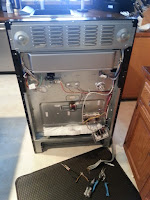
So I popped my meter across the leads for the broil element: Looked good at 14ohms.
The baking element on the bottom, not so good. No continuity. Should be at roughly 17ohms according to the service manual. So I pulled it out.
Pulling out the bottom element required the removal of the incoming power terminal block as well as clipping some strategic points with a metal shears. An angle wire cutter would work perfect as well. After that you have to peel back some fiberglass insulation to get at the bracket with screws on it. Got the remaining screws out then gently tugged the thing out.
After I got the element I found it to be very severely blistered in a 6” section, and broken in the middle:eek: . Yep that was definitely a problem! Probably the reason for the loud noise, the element arching like crazy and boiling over. See the photos.

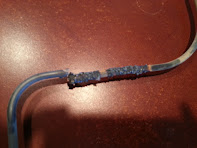
So I was like at least I found the problem, but, great, how much is this gonna cost me? Went back online, found the bake element (after a while of searching for LG parts) for like $38. Not to shabby.
Ordered it and waited the 3 days to ship, thinking, I’m the man – it’s as good as fixed.:cool:
Got it out of the box and installed it in reverse order, being very gentle with the new element (even wore gloves to avoid getting hand oils on it).
Reattach all the terminals, leads, close it up, etc and begin preheating to 450F. Everything’s looking good so far it’s heating up fast! Relays are clicking in the back like it’s working well on that new element.
It gets to 385 or so and then quits getting hotter. It does the exact same thing as it did prior to the new element install. WTF?:mad: Back to the drawing board.
Start digging deeper, nothing else “appears” to be broken, thermostat is reading correct ohms, thermal fuse is good, everything else on the cooktop works like a dream. Just would not get up through those extra 50F or so….
Though it looked like it was in wonderful shape from the front, I decided to take all the leads off and pull out the oven relay PCB, which according to most troubleshooting manuals would be the next place to check.
Once I got the leads off and unscrewed the board, it was apparent that the board had fried.:eek: Big black spot on the back of the board and the oven shell. The circuit board shorted out and burned right through. See the photos.
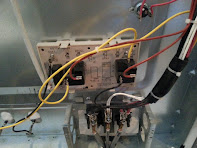
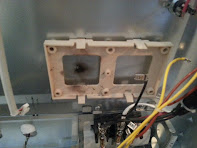
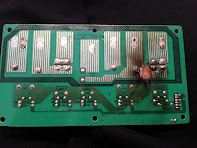
I was like, oh great, now how much is this gonna cost me? $28 online, shipped in 2 days.
Waited anxiously, plugged the new one in, and hit bake for 450. This time I monitored current going to the elements with my meter (clamp on style). Heated up quickly from 0-385F, then it paused. I was like here we go. And then I got that whiff of, oh yeah, new oven element. It started to pull itself up and inched its way all of the way to 450F. Problem solved.
But why the pauses and lapses in heat? Why could it get to 285, or 385 every time, but not to 450? Well, here’s my theory, and I think I can prove it now that I had my Amp readings for the elements.
Seems like the broil element (or a combo of broil + bake) is used to get the oven really hot quickly, and then the more even bake element is used to finish the preheat and to hold the temp as you bake. Obviously the relay sending power to the bake element for that last kick-in was not working due to the PCB blowout. The main PCB (the brain of the oven) still thought it was kicking everything in correctly. And since there were no main oven fault codes, it made sense that the main PCB was unaffected.
I then let it cool and did it again with my amp meter. Sure enough, that bake element kicked it in at the last part of the preheat 12-14 amps or so and stayed on.
At any rate, I got out of it without having to call a tech, saved some money (about 65 bucks for the components), and I learned a ton about making repairs to appliances (this was my first crack at any kitchen appliance). All in all, I’m glad I did it, and it didn’t take more than a little research, a little intuition, and a little cash.
Feel free to comment or ask questions, thanks for reading.
Brian